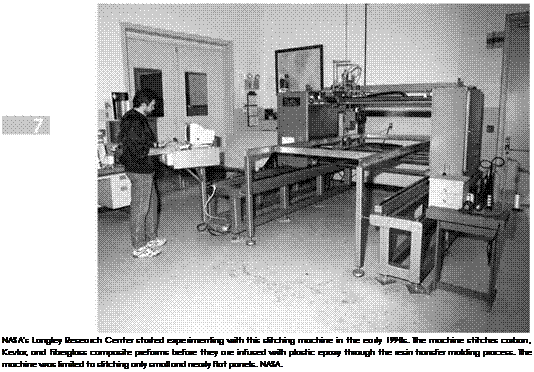Toward the Future
NASA remains active in the pursuit of new materials that will support fresh objectives for enabling a step change in efficiency for commercial aircraft of the next few decades. A key element of NASA’s strategy is to promote the transition from conventional, fuselage-and – wing designs for large commercial aircraft to flying wing designs, with the Boeing X-48 Blended Wing-Body subscale demonstrator as the model. The concept assumes many changes in current approaches to

flight controls, propulsion, and, indeed, expectations for the passenger experience. Among the many innovations to maximize efficiency, such flying wing airliners also must be supported by a radical new look at how composite materials are produced and incorporated in aircraft design.
To support the structural technology for the BWB, Boeing faces the challenge of manufacturing an aircraft with a flat bottom, no constant section, and a diversity of shapes across the outer mold line.[772] To meet these challenges, Boeing is returning to the stitching method, although with a different concept. Boeing’s concept is called pultruded rod stitched efficient unitized structure (PRSEUS). Aviation Week & Space Technology described the idea: "This stitches the composite frames and stringers to the skin to produce a fail-safe structure. The frames and stringers provide continuous load paths and the nylon stitching stops cracks. The design allows the use of minimum-gauge-post-buckled-skins, and Boeing
estimates a PRSEUS pressure vessel will be 28% lighter than a composite sandwich structure.”[773]
![]() Under a NASA contract, Boeing is building a 4-foot by 8-foot pressure box with multiple frames and a 30-foot-wide test article of the doubledeck BWB airframe. The manufacturing process resembles past experience with the advanced stitching machine. Structure laid up by dry fabric is stitched before a machine pulls carbon fiber rods through pickets in the stringers. The process locks the structure and stringers into a preform without the need for a mold-line tool. The parts are cured in an oven, not an autoclave.[774]
Under a NASA contract, Boeing is building a 4-foot by 8-foot pressure box with multiple frames and a 30-foot-wide test article of the doubledeck BWB airframe. The manufacturing process resembles past experience with the advanced stitching machine. Structure laid up by dry fabric is stitched before a machine pulls carbon fiber rods through pickets in the stringers. The process locks the structure and stringers into a preform without the need for a mold-line tool. The parts are cured in an oven, not an autoclave.[774]
The dream of designing a commercially viable, large transport aircraft made entirely out of plastic may finally soon be realized. The allcomposite fuselage of the Boeing 787 and the proposed Airbus A350 are only the latest markers in progress toward this objective. But the next generation of both commercial and military transports will be the first to benefit from composite materials that may be produced and assembled nearly as efficiently as are aluminum and steel.










